Galeamopus
Galeamopus is a genus of herbivorous diplodocid sauropod dinosaurs. It contains two known species: Galeamopus hayi, known from the Late Jurassic lower Morrison Formation (Kimmeridgian age, about 155 million years ago) of Wyoming, United States, and Galeamopus pabsti, known from the Late Jurassic fossils from Wyoming and Colorado. The type species is known from one of the most well preserved diplodocid fossils, a nearly complete skeleton with associated skull.
| Galeamopus | |
|---|---|
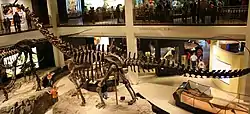 | |
| Mounted G. hayi holotype skeleton, Houston Museum of Natural Science | |
| Scientific classification | |
| Kingdom: | Animalia |
| Phylum: | Chordata |
| Clade: | Dinosauria |
| Clade: | Saurischia |
| Suborder: | †Sauropodomorpha |
| Clade: | †Sauropoda |
| Clade: | †Eusauropoda |
| Clade: | †Neosauropoda |
| Family: | †Diplodocidae |
| Subfamily: | †Diplodocinae |
| Genus: | †Galeamopus Tschopp et al., 2015 |
| Type species | |
| †Diplodocus hayi Holland, 1924 | |
| Species | |
| |
| Synonyms | |
|
Diplodocus hayi Holland, 1924 (type) | |
History
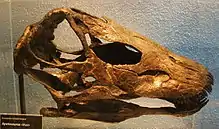
Galeamopus was first known from a partial skeleton discovered by fossil hunter William H. Utterback in 1902 near Sheridan, Wyoming, in the Red Fork Powder River Quarry A. In 1906, the skeleton was referred to Diplodocus by William Jacob Holland when he described its braincase.[1] The specimen was classified by Holland as a new species of Diplodocus, Diplodocus hayi, in 1924. The specific name honoured Oliver Perry Hay.[2]
In 2015, it was renamed as the separate genus Galeamopus by Emanuel Tschopp, Octávio Mateus and Roger Benson. The generic name is derived from Latin galeam, the accusative of galea, "helmet", and opus, "need". The combination is intended as a translation of Wil-helm, literally "want helmet", in reference to the first name of both Utterback and Holland. The name is at the same time an allusion to the fact that the brittle braincase of the type specimen is in need of a helmet.[3]
The genoholotype is HMNS 175 (previously CM 662), the original skeleton. It was found in layer of the lower Morrison Formation dating from the Kimmeridgian. This specimen is also the holotype of Galeamopus hayi, the combinatio nova of the type species D. hayi. Several other specimens were referred to the genus Galeamopus but not to Galeamopus hayi. These included specimen AMNH 969, a nearly complete skull discovered in 1903 at the Bone Cabin Quarry by Peter Kaisen; and specimen USNM 2673, a partial skull excavated in 1884 by Marshall P. Felch at Garden Park in Colorado.
SMA 0011, a skeleton nicknamed "Max" and found in June 1995 at the Howe-Stephens Quarry, was considered sufficiently different from the others to consider naming a separate species for it.[3] In 2017, the "Max" specimen was made the type specimen of a second Galeamopus species, G. pabsti, by Tschopp and Mateus. It was named after the Swiss paleontologist Dr. Ben Pabst, who discovered the specimen and helped mount the skeleton at Sauriermuseum Aathal.[4]
Description
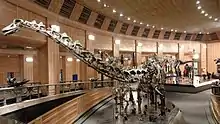
The 2015 study established seven distinguishing traits of the genus as such. These were autapomorphies, unique derived characters. On the back of the skull, the paroccipital process is curved in side view. The teeth have paired wear facets. The first neck vertebra, the atlas, has a neural spine with processes pointing to the front and the inside, which are separate from the rear wing of the spine. This rear wing shows a continuous transverse width over most of its length. The neural arch of the atlas has on each side of its base a small triangular spur. The second neck vertebra, the axis, has a neural spine with a knob-shaped bump on the front end of the ridge on its front side. With the middle and rear neck vertebrae, the ridge between the rear joint processes, the postzygapophyses, does not extend beyond the rear edge of the neural arch.[3]
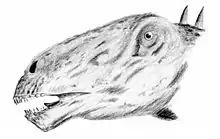
The study also determined six autapomorphies of the type species Galeamopus hayi alone. The part of the parietal bone forming the edge between the rear skull and the skull roof is low, with a height less than that of the foramen magnum. The appending basipterygoid processes at the underside of the braincase strongly diverge at an angle of more than 60°. The ulna of the lower arm is long, with a minimum length equalling 76% of the humerus, upper arm bone, length. The surface on the radius contacting the ulna is limited in size and relatively smooth. The joint surface at the underside of the radius is bevelled relative to the shaft, at an angle of about 15°. The outer edge of the top surface of the shinbone forms a pinched process, behind the cnemial crest at the front.[3]

Combined, there are thirteen autapomorphies present in Galeamopus, exactly the minimum the study used as a criterion to distinguish separate genera.[3]
Relationships
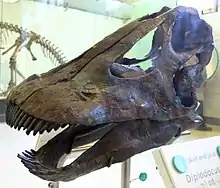
The cladogram below shows one hypothesis on the relationships of Galeampous to other diplodocids, as found by the analysis of Tschopp & Mateus (2017).[4]
| Diplodocidae |
| ||||||||||||||||||||||||||||||||||||||||||||||||||||||||||||||||||||||||||||||||||||||||||
See also
References
- Holland, W.J. (1906). "The osteology of Diplodocus Marsh". Memoirs of the Carnegie Museum. 2: 225–264.
- Holland WJ. The skull of Diplodocus. Memoirs of the Carnegie Museum IX; 379–403 (1924).
- Tschopp, E.; Mateus, O. V.; Benson, R. B. J. (2015). "A specimen-level phylogenetic analysis and taxonomic revision of Diplodocidae (Dinosauria, Sauropoda)". PeerJ. 3: e857. doi:10.7717/peerj.857. PMC 4393826. PMID 25870766.
- Emanuel Tschopp; Octávio Mateus (2017). "Osteology of Galeamopus pabsti sp. nov. (Sauropoda: Diplodocidae), with implications for neurocentral closure timing, and the cervico-dorsal transition in diplodocids". PeerJ. 5: e3179. doi:10.7717/peerj.3179. PMC 5417106. PMID 28480132.













